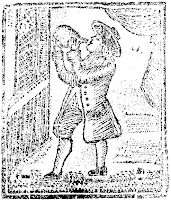What Washington Really Did about the Gunpowder
Having expressed great skepticism about James T. Flexner’s statement that George Washington directed a disinformation campaign to conceal the Continentals’ lack of gunpowder from the British, I feel I should address what the general actually did.
After all, Washington didn’t just sit there, not saying anything. Actually, he did, but only for half an hour, according to Gen. John Sullivan.
After that, the commander-in-chief wrote urgent letters to the executive authorities of the neighboring colonies and the Continental Congress, asking for any gunpowder they had. Those letters appear to have sped up shipments a bit, and some powder was already on its way to the army. The crisis Washington and his generals perceived lasted only a few days, though lack of ammunition continued to limit their action for a while.
Washington also proposed or endorsed two audacious ways to seize powder from British outposts. The American generals learned about the shortage at a 3 Aug 1775 council of war, and the minutes show their response:
It was proposed to make an attempt on the Magazine at Halifax where there is reason to suppose there is a great quantity of Powder. And upon the Question being seriously put, it was agreed to, by a great majority, and that the detachment for this enterprise consist of 300 Men.This raid on one of the British military’s main garrisons in North America never took place. Which was probably good from the American point of view, since the plan seems to have been a bit too optimistic.
In a monograph titled “George Washington’s Armed Schooner,” Allen B. Hovey has suggested that preparation for that assault on Halifax prompted Washington to look into arming a ship for the first time. Later, after he had sent the Hannah to sea, the general told John Langdon of New Hampshire that schooner was part of “a scheme I had in view with the People of Hallifax.” So that 3 August plan might have produced results, just not the results the council of war had in mind.
The next day, Washington suggested a different naval expedition to Gov. Nicholas Cooke of Rhode Island:
one Harris is lately come from Bermuda, where there is a very considerable Magazine of Powder in a remote Part of the Island and the Inhabitants well disposed not only to our Cause in General, but to assist in this Enterprize in particular; we understand there are two Armed Vessels in your Province commanded by Men of known Activity and Spirit; one of which it is proposed to dispatch on this Errand, with such other assistance as may be required; Harris is to go along as the Conductor of the Enter prize and to avail ourselves of his knowledge of the Island, but without any Command. I am very sensible that at first view the project may appear hazardous and its Success must depend on the Concurrence of many Circumstances; but we are in a Situation which requires us to run all Risques.Capt. Abraham Whipple did indeed head to Bermuda, but not until mid-September, as he later described. That expedition didn’t produce any powder, either, because a lot of it had already been stolen away. But we can’t say Gen. Washington didn’t think big.




